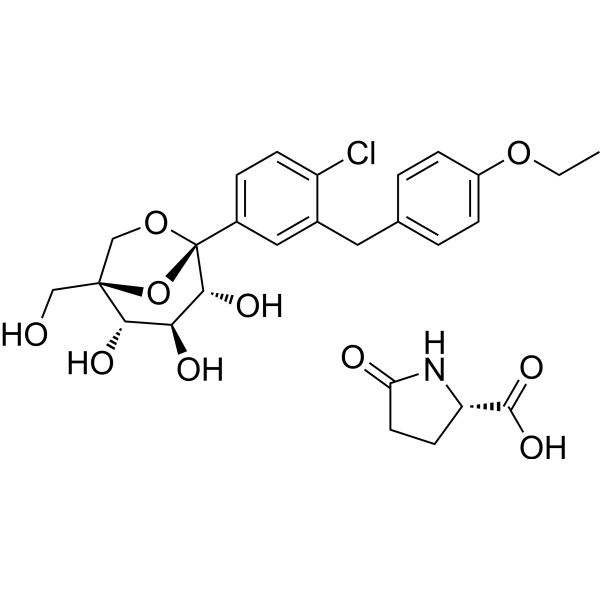
Ertugliflozin L-pyroglutamic acid
CAS No. 1210344-83-4
Ertugliflozin L-pyroglutamic acid ( PF-04971729 L-pyroglutamic acid )
产品货号. M26680 CAS No. 1210344-83-4
Ertugliflozin L-焦谷氨酸是一种选择性、口服活性的 hSGLT2 抑制剂,IC50 为 0.877 nM。
纯度: >98% (HPLC)
 COA
COA
 Datasheet
Datasheet
 HNMR
HNMR
 HPLC
HPLC
 MSDS
MSDS
 Handing Instructions
Handing Instructions
| 规格 | 价格/人民币 | 库存 | 数量 |
| 5MG | ¥316 | 有现货 |


|
| 10MG | ¥446 | 有现货 |


|
| 25MG | ¥664 | 有现货 |


|
| 50MG | ¥786 | 有现货 |


|
| 100MG | ¥1158 | 有现货 |


|
| 200MG | ¥1693 | 有现货 |


|
| 500MG | ¥2900 | 有现货 |


|
| 1G | 获取报价 | 有现货 |


|
生物学信息
-
产品名称Ertugliflozin L-pyroglutamic acid
-
注意事项本公司产品仅用于科研实验,不得用于人体或动物的临床与诊断
-
产品简述Ertugliflozin L-焦谷氨酸是一种选择性、口服活性的 hSGLT2 抑制剂,IC50 为 0.877 nM。
-
产品描述Ertugliflozin L-pyroglutamic acid is a selective and orally active hSGLT2 inhibitor with an IC50 of 0.877 nM. Ertugliflozin L-pyroglutamic acid can be used for studies about the treatment of type 2 diabetes mellitus.(In Vitro):Ertugliflozin L-pyroglutamic acid demonstrated >2000-fold selectivity for SGLT2 over SGLT.(In Vivo):The oral administration of Ertugliflozin L-pyroglutamic to rats acid showed concentration-dependent glucosuria.
-
体外实验——
-
体内实验——
-
同义词PF-04971729 L-pyroglutamic acid
-
通路Others
-
靶点Other Targets
-
受体Caspase-3
-
研究领域——
-
适应症——
化学信息
-
CAS Number1210344-83-4
-
分子量566
-
分子式C27H32ClNO10
-
纯度>98% (HPLC)
-
溶解度In Vitro:?DMSO : ≥ 125 mg/mL (220.85 mM)
-
SMILESOC(=O)[C@@H]1CCC(=O)N1.CCOc1ccc(Cc2cc(ccc2Cl)[C@]23OC[C@](CO)(O2)[C@@H](O)[C@H](O)[C@H]3O)cc1
-
化学全称——
运输与储存
-
储存条件(-20℃)
-
运输条件With Ice Pack
-
稳定性≥ 2 years
参考文献
1.Kravchenko DV, et al. Synthesis and structure-activity relationship of 4-substituted 2-(2-acetyloxyethyl)-8-(morpholine-4-sulfonyl)pyrrolo[3,4-c]quinoline-1,3-diones as potent caspase-3 inhibitors. J Med Chem. 2005 Jun 2;48(11):3680-3.
产品手册




关联产品
-
Allisartan Isoproxil
Allisartan Isoproxil 是一种血管紧张素 II 受体拮抗剂,用于治疗轻度至中度原发性高血压。
-
NH2-PEG2-C6-Cl hydro...
2-(2-(6-chlorohexyloxy)ethoxy)ethanamine (hydrochloride) 是一种 PROTAC linker,属于 PEG 类,可用于合成 PROTAC 分子。
-
Deferitazole
Deferitazole (FBS 0701) is a novel and orally active, selective and high affinity iron chelator.



 021-51111890
021-51111890 购物车()
购物车()
 sales@molnova.cn
sales@molnova.cn







